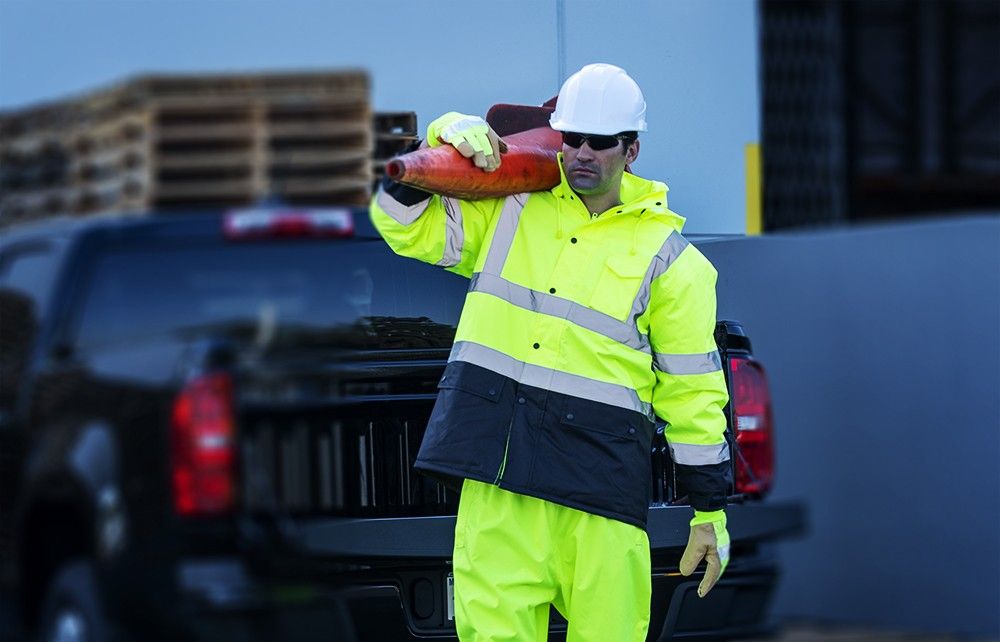Safety hazards at construction sites are present all year round, but wintertime can bring in seriously dangerous working conditions. With lower temperatures and bad weather, the risk of cold-related accidents and injuries is at an all-time high.
Three big weather risks are most often identified with winter construction worksites. They include:
- Cold Stress Illnesses
- Icy Slip, Trip, and Fall Risks
- Work Zone Traffic Dangers
Below we’ll look at what each risk includes and what industry experts say are the most successful ways of protecting workers from these wintertime hazards.
1. Cold Stress Illnesses
There’s no doubt that cold outdoor environments can endanger workers. But, it’s actually more than just the cold. You can blame it on the wind too. As the wind speed increases, it causes the air temperature to feel even colder.
Wet weather is another concerning element in the mix, said Brenda Jacklitsch, a health scientist at the National Institute of Occupational Safety & Health (NIOSH), in her article for the CDC website. She pointed out that a combination of all three elements: low temperature, wind speed, and wet conditions can lead to illness even at moderate temperatures as the diagram below shows.
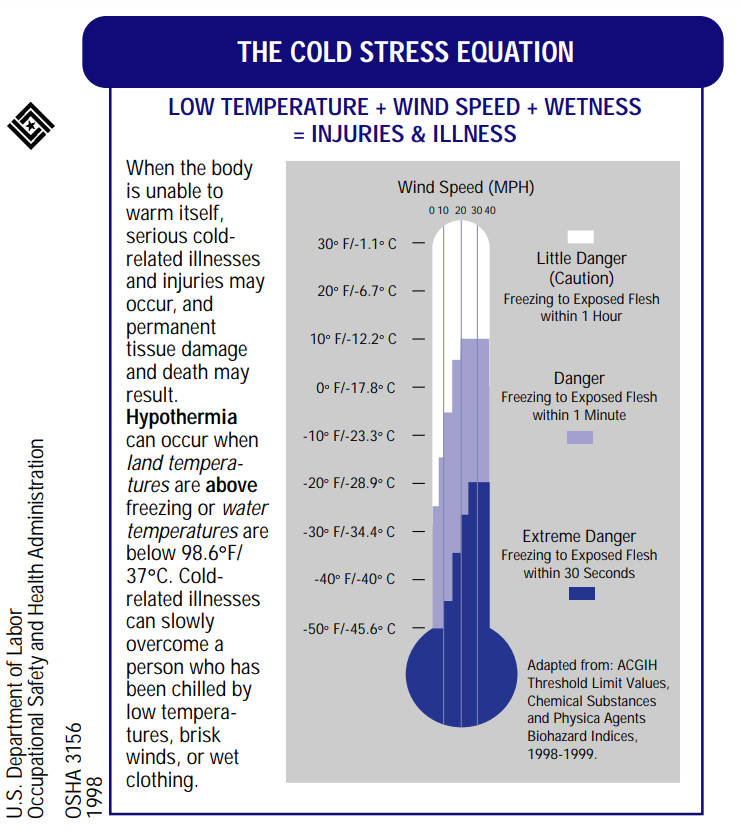
Exposure to these conditions causes skin temperatures to drop and, in time, the body’s core temperature to drop below the healthy average of 37°C. When the body is unable to warm itself, severe cold-related illnesses referred to as cold stress could occur.
 |
“What may be common knowledge for one person—say someone who grew up with cold weather conditions—may be new information for someone who has never before experienced snow, ice, or falling temperatures. There is also a lot of misinformation, so by spending a little time providing accurate information to all workers, injuries and illness may be prevented.”
– Brenda Jacklitsch, Health Scientist at NIOSH |
For more information on cold stress illnesses like hypothermia, frostbite, trench foot, and chilblains, including symptoms and first aid, visit the NIOSH topic page on Cold Stress.
Preventing Cold Stress Illnesses
Worksite regulations specifically target cold stress because it can cause serious physical harm or even death to workers.
The American Conference of Governmental Industrial Hygienists (ACGIH) developed the “Work/Warm-up Schedule for a 4-hour shift.” It takes both air temperature and wind speed into account to provide recommendations on scheduling work breaks and ceasing non-emergency work.
Work/Warm-up Schedule for a 4-Hour Shift
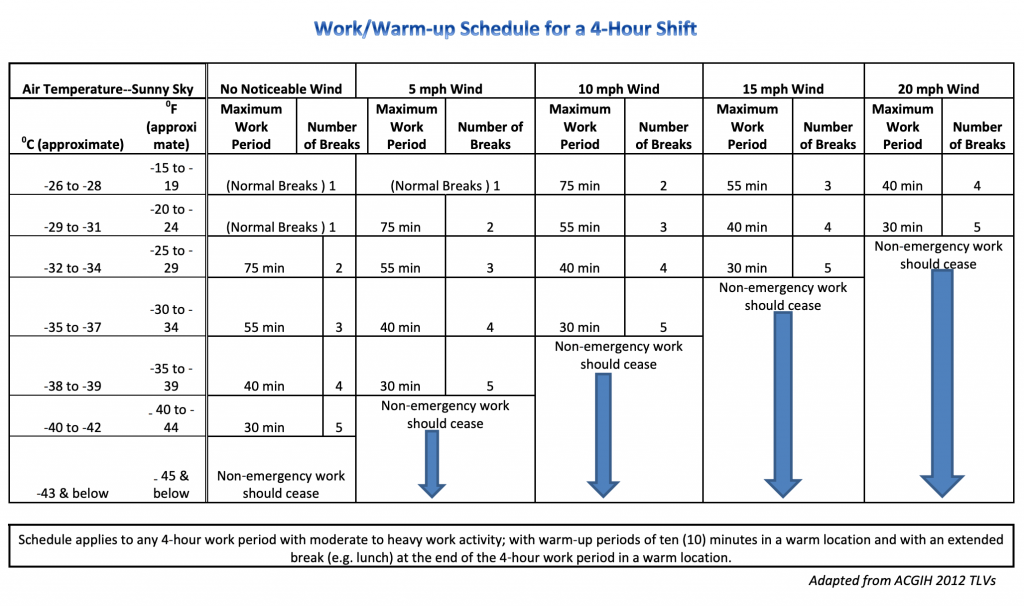
When cold environments cannot be avoided, workers should follow the 4-hour shift schedule. NIOSH also advises moving into warm locations during work breaks and limiting the amount of time outside on extremely cold days.
They recommend workers should also carry cold-weather gear, such as extra socks, gloves, hats, jackets, blankets, a change of clothes, and a thermos of hot liquid. And first aid kits should have a thermometer and chemical hot packs.
Finally, NIOSH suggests workers exercise the following behaviors to keep safe:
- Avoid touching cold metal surfaces with bare skin
- Monitor your physical condition and that of your coworkers
- Dress for the conditions, including personal protective equipment (PPE)
PPE for cold work environments
Typically, PPE is considered the last line of defense for worker protections. However, when it comes to the cold weather in outdoor environments, clothing and PPE play a significant role. Important safeguards from worker PPE should include insulating layers of warm material, wind-chill protection, and protective covering for wet/rainy conditions.
Employers must provide PPE when required by OSHA standards to protect workers’ safety and health. But, there is actually no official OSHA requirement for employers to provide workers with ordinary clothing or other items used solely for protection from the weather (29 CFR 1910.132(h)(4)).
Despite that, many employers provide their workers with winter weather gear such as winter coats/jackets and gloves.
For another article in Safety and Health Magazine Jacklitsch warns that finding a balance between what you’re wearing and the type of job you’re doing is critical.
“You need to be aware that having extra PPE on may restrict some of your movements, so you need to be more careful.”
NIOSH tips on wearing protective clothing safely
● Wear several layers of loose clothing. Layering provides better insulation.
● Avoid tight clothing because it reduces blood circulation. Warmblood needs to be circulated to the extremities.
● When choosing clothing, be aware that some clothing may restrict movement resulting in a hazardous situation.
● Make sure to protect the ears in freezing weather.
● Boots should be waterproof and insulated.
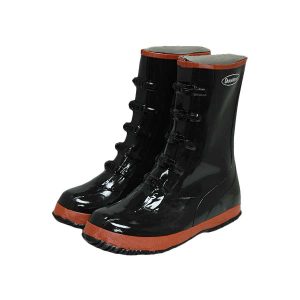
Caption: It’s important to keep your feet dry and warm outside in the winter months. The Durawear 5-buckle Arctic boot can do the trick and the sole helps prevent slips.
● Wear a hat; it will keep your whole body warmer. (Hats reduce the amount of body heat that escapes from your head.)
● Use an insulated coat/jacket (water-resistant if necessary)
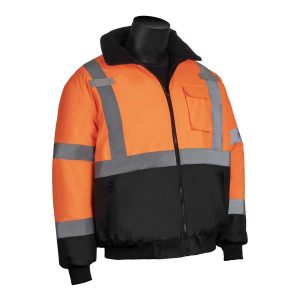
Caption: Staying warm, and dry is critical. The Class 3 insulated black bottom bomber jacket is just what you need to stay seen on a winter construction site.
● Cover face and mouth (if needed) with knit mask
● Protect hands with insulated gloves (water resistant if necessary)
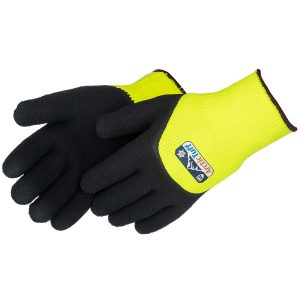
Caption: Keeping your hands warm and protected from the cold is essential. The Arctic Tuff line of protective gloves provides a thermal, 13-gauge, hi-vis color, nylon shell and black, foam latex, palm coating.
2. Icy Slip, Trip, and Fall Risks
Even if dressed for the weather, outside workers need to continue to exercise caution. OHSA reports that slips, trips, and falls make up a large part of workplace accidents, and they are the cause of 15 percent of all accidental fatalities.
Even though these accidents can occur any time of the year, the snow and ice of winter make for an increase in hazardous conditions and the risks of serious injury.
According to the U.S. Bureau of Labor Statistics (BLS), in a survey that looked at incident rates from 2008 to 2017, the yearly average was over 20,000 occupational injuries related just to ice, sleet, and snow.
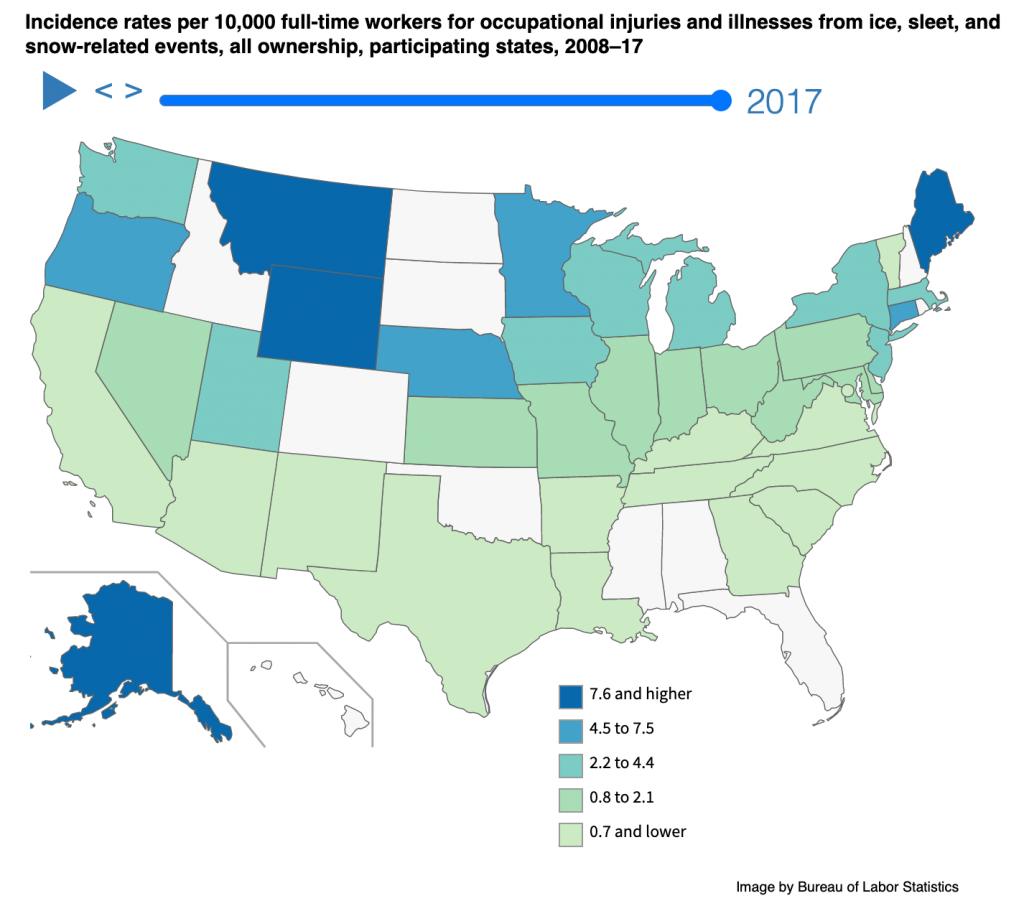
On winter construction sites workers are faced with super slippery surfaces from parking lots, sidewalks, and roads. Often there is not only snow to deal with but layers of ice can be hidden underneath. Its critical workers are prepared.
Preventing weather-related accidents
Because walking on the snow and ice is unavoidable on a winter construction site, OSHA and National Oceanic and Atmospheric Administration (NOAA) work together to help workers learn how to respond to severe weather hazards.
Together they create and distribute information about wintertime risks including slips, trips and falls along with other dangers that workers may face during and after winter storms, and recommend the following:
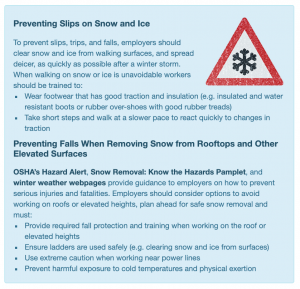
3. Work Zone Traffic Dangers
Yet another danger winter construction workers face is working around moving vehicles. And the winter weather makes that an even more dangerous situation.
The U.S. Department of Transportation (DOT) sites 24 percent of weather-related vehicle crashes happen on icy, slushy, or snowy roads. According to that same report, more than 1,300 people are killed on roads under those same conditions every year, and snowfall and sleet cause an additional 900 deaths.
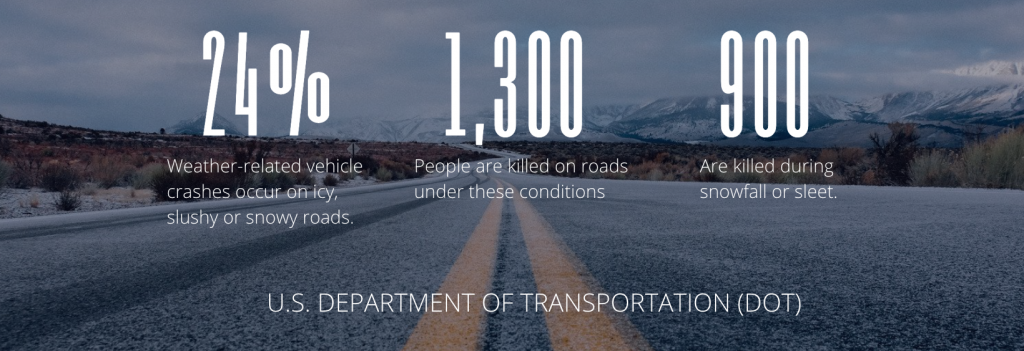
Seventy percent of the nation’s roads are located in snowy regions and the Federal Highway Administration points out that road maintenance issues in these areas are higher due to the increase in snow and ice.
This means road construction must continue even in the winter months, and construction workers will need to work in hazardous winter situations where vehicles are often present.
Work Zone Safety
Because drivers may skid or lose control of their cars more easily when driving on snow and/or ice-covered roads, construction workers being struck by vehicles is a real risk of the job. Workers exposed to vehicular traffic should wear the appropriate high visibility vest at all times so that they can be visible to motorists.
OSHA stresses the importance of properly setting up work zones during the winter months as a way to prevent accidents and recommends:
Work Zone Protections: Various concrete, water, sand, collapsible barriers, crash cushions, and truck-mounted impact absorbers can help limit unauthorized entry by motorists into construction work zones.
Flagging: Flaggers should wear high-visibility clothing with a fluorescent background and made of retroreflective material. This makes workers visible for at least 1,000 feet in any direction. Drivers should be warned with signs that there will be flaggers ahead. Flaggers should use STOP/SLOW paddles, paddles with lights, or flags (only in emergencies).
Lighting: Flagger stations should be well lit. Lighting for workers on foot and equipment operators should be at least five-foot candles or greater. Where available lighting is not sufficient, flares or chemical lighting should be used. Glare should be controlled or eliminated.
Training: Flaggers must be trained/certified and use authorized signaling methods. Driving: Seat belts and rollover protection should be used on equipment and vehicles as the manufacturer recommends.
Learn more at Work Zone Traffic Safety (OSHA QuickCard™) and Highway Work Zones and Signs, Signals, and Barricades (OSHA Safety and Health Topics Page)
Winter construction work requires working smart
In construction, there is no room for error, particularly in the winter when it comes to workplace safety in and around a worksite. However, cold weather doesn’t have to stop productivity. With the correct equipment and by following recommended controls, construction workers can stay safe all year long.
Identifying and minimizing cold-weather risks and ensuring the right gear is available will help keep winter construction workers warm, dry and safe throughout the season.
When it comes time to find the best selection of PPE for those winter months, Liberty Glove and Safety can help. Contact us to learn more about our line of personal protective equipment.

